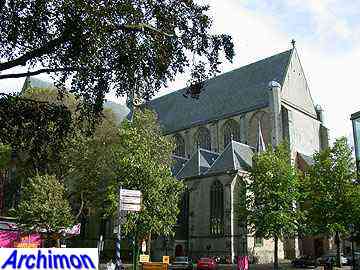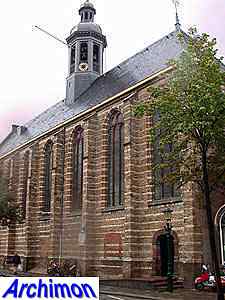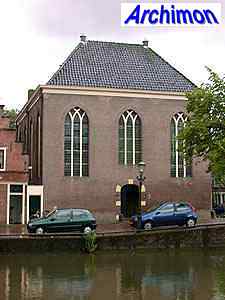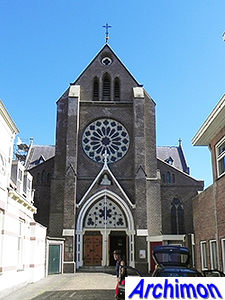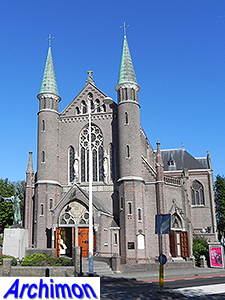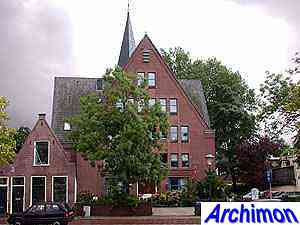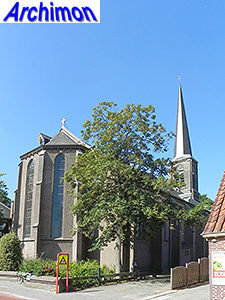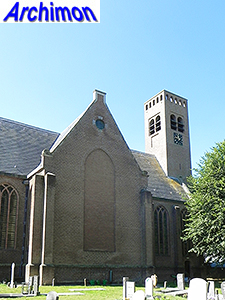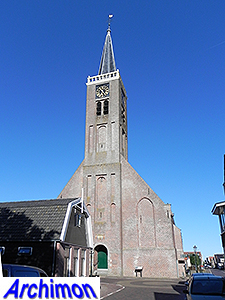 Alkmaar municipality / Gemeente Alkmaar (NH) Alkmaar is the third largest city of the Noord-Holland province, after Amsterdam and Haarlem. The city lies at the border of the regions Kennemerland and West-Friesland. The eponymous municipality includes a large area to the east and south-east of the city, with 16 villages. This page shows buildings in Alkmaar and some of the villages. Alkmaar is in omvang de derde stad van Noord-Holland, na Amsterdam en Haarlem. De stad ligt op de grens van de regio's Kennemerland en West-Friesland. De gelijknamige gemeente omvat verder een groot gebied ten oosten en zuid-oosten van de stad, met daarin 16 dorpen. Deze pagina toont een aantal kerken in Alkmaar en enkele van deze dorpen. |
|
The Grote Kerk, also known as St. Laurens, is a basilica in Brabantine Gothic style. It was built from 1470 until 1520. In 1572 the protestants confiscated the church. Today it is mostly used for cultural purposes. Location: Koorstraat 2 De Grote Kerk, ook bekend als St. Laurens, is een basiliek in Brabantse gotiek. De kerk werd gebouwd van 1470 tot 1520. In 1572 namen de protestanten de kerk in beslag. Tegenwoordig wordt zij vooral gebruikt voor culturele doeleinden. Locatie: Koorstraat 2 |
|
The Kapelkerk is a two-aisled church in Gothic style built in ca. 1520. A transept-arm in Classical style was added to the north side in 1707. Location: Kapelsteeg 3 De Kapelkerk is een tweebeukige kerk in gotische stijl, gebouwd rond 1520. Aan de noordzijde werd in 1707 een transeptarm in classicistische stijl toegevoegd. Locatie: Kapelsteeg 3
|
|
Location: Oudegracht 187 De Lutherse kerk werd gebouwd in 1692 en is een zaalkerk met een bescheiden exterieur die de toenmalige positie van de lutheranen als tweederangs burgers weerspiegelt. Locatie: Oudegracht 187
|
|
Location: Verdronkenoord 68 De rooms-katholieke St. Laurentius werd ontworpen door architect P.J.H. Cuypers in neogotische stijl en gebouwd in 1859-1861. Oorspronkelijk voorzag het ontwerp in een toren, waarvan echter alleen het onderste gedeelte werd gebouwd. Locatie: Verdronkenoord 68
|
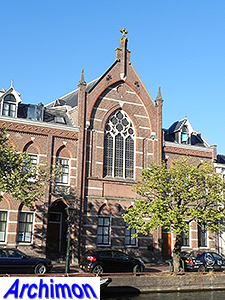 The convent or Zusterhuis of the Zusters van Onze Lieve Vrouw van Amersfoort ('sisters of Our Lady of Amersfoort') was built in 1889 in neo-Gothic style by design of C.L.M. Robbers. In 1925 the complex was extended in a matching style by H. Kroes. The whole complex often is incorrectly attributed to Kroes. Location: Oudegracht 214a Het klooster of Zusterhuis van de Zusters van Onze Lieve Vrouw van Amersfoort werd in 1889 gebouwd in neogotische stijl naar ontwerp van C.L.M. Robbers. In 1925 werd het complex in een bijpassende stijl door H. Kroes uitgebreid. Het hele complex wordt vaak ten onrechte toegeschreven aan Kroes. Locatie: Oudegracht 214a |
|
Another catholic neo-Gothic church is the St. Joseph which was built in 1909 after a design by architects A.A.J. Margry, Jos. Margry & J.M. Snickers. Location: Nassaulaan 2 Een andere katholieke neogotische kerk is de St. Jozef, die in 1909 werd gebouwd naar een ontwerp van architect A.A.J. Margry, Jos Margry en J.M. Snickers. Locatie: Nassaulaan 2
|
|
The former Verlosserkerk was built as a protestant church in 1933. It was one of many churches architect B.W. Plooij designed in Expressionist style. In the 1990's the building was rebuilt into apartments. Location: Kwerenpad 15-16 De voormalige Verlosserkerk is gebouwd als een gereformeerde kerk in 1933. Het was een van de vele kerken die architect B.W. Plooij ontwierp in expressionistische stijl. In de jaren 1990 werd het gebouw omgebouwd tot appartementen. Locatie: Kwerenpad 15-16
|
Oudorp 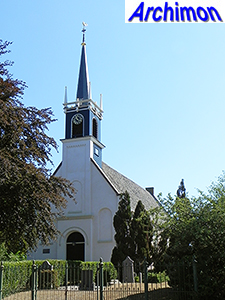 The reformed church is an aisleless church in neo-Classical style and is the result of a drastic transformation in 1858 of a 16th-century church. The current facade and tower were added in 1867, after the old tower collapsed. Location: Herenweg 4 De hervormde kerk is een zaalkerk in neoclassicistische stijl en is het resultaat van een drastische verbouwing van een 16e-eeuwse kerk in 1858. De huidige voorgevel en toren werden toegevoegd in 1867, nadat de oude toren was ingestort. Locatie: Herenweg 4 |
|
The St. Laurentius is a three-aisled pseudo-basilica in neo-Gothic style, designed by E.J. Margry and built in 1879-1880 to replace an 18th-century hidden church. Location: Herenweg 79 De St. Laurentius is een driebeukige pseudobasiliek in neogotische stijl, ontworpen door E.J. Margry en gebouwd in 1879-1880 als opvolger van een 18e-eeuwse schuilkerk. Locatie: Herenweg 79 |
| Stompetoren
The reformed church is an aisless cruciform church in a more or less Gothic style, designed by Pieter Post, an architect best known for his houses in Classical style. It was built in 1662-1663 as a protestant church in one of the two villages in the Schermer polder, a former lake which had been reclaimed just 27 years earlier. The village eventually was named after its spire-less tower ('stump tower'). Location: Noordervaart 122 De hervormde kerk is een eenbeukige kruiskerk in een min of meer gotische stijl en werd, ontworpen door Pieter Post, een architect die vooral bekend is om zijn huizen in classicistische stijl. De kerk werd gebouwd in 1662-1663 als protestantse kerk in een van de twee dorpen in de Schermer, een voormalig meer dat pas 27 jaar eerder was drooggemaakt. Het dorp is uiteindelijk vernoemd naar zijn spitsloze toren.Locatie: Noordervaart 122
|
| Schermerhorn
The reformed church or Grote Kerk is a three-aisled pseudo-basilica built in 1634-1636. The Gothic style is a remarkable choice for a church specifically built for protestant use. Location: Oosteinde 2 De hervormde kerk of Grote Kerk is een driebeukige pseudobasiliek uit 1634-1636. De gotische stijl is een opvallende keuze voor een kerk die speciaal is gebouwd voor protestants gebruik. Locatie: Oosteinde 2 |
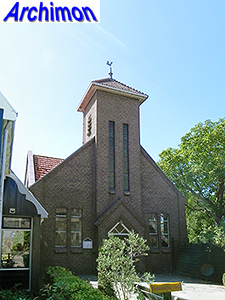 The Gereformeerde kerk is a small cruciform aisleless church in Expressionist style, designed by an unknown architect. It was built in 1924, replacing a church destroyed by fire the previous year. Location: Westeinde 88 De Gereformeerde kerk is een kleine kruisvormige zaalkerk in expressionistische stijl, ontworpen door een onbekende architect. De kerk werd gebouwd in 1924, ter vervanging van een kerk die het voorgaande jaar door brand was verwoest. Locatie: Westeinde 88 |
|
|
